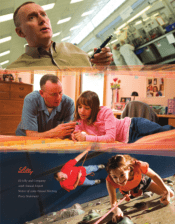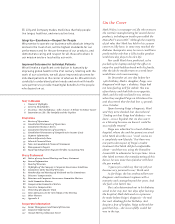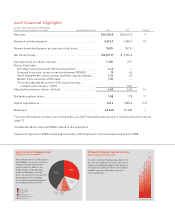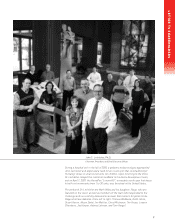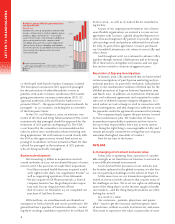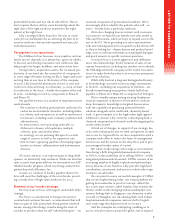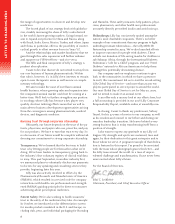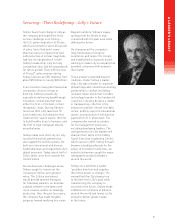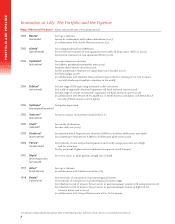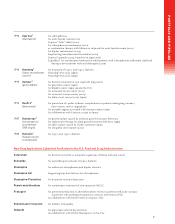Eli Lilly 2008 Annual Report Download - page 7
Download and view the complete annual report
Please find page 7 of the 2008 Eli Lilly annual report below. You can navigate through the pages in the report by either clicking on the pages listed below, or by using the keyword search tool below to find specific information within the annual report.
LETTER TO SHAREHOLDERS
5
predictable benefi t and less risk of side effects. This in
turn requires that we deliver more knowledge about the
right dose of the right medicine matched to the right
patient at the right time.
Lilly’s strategy follows from this: We aim to create
value for our stakeholders by accelerating the fl ow of in-
novative medicines that provide improved outcomes for
individual patients.
The pipeline is our top priority
The lifeblood of our business is our pipeline, and our
future success depends, as it always has, upon our ability
to discover and develop innovative new medicines that
help people live longer, healthier, and more active lives.
Owing both to acquisitions and to the increased pro-
ductivity of our own labs, the current list of compounds
in some stage of human testing at Lilly is larger and more
exciting than at any time in the history of the company.
In 2008, Lilly Research Laboratories moved 17 new mol-
ecules into clinical testing. As of January 31, 2009, we had
60 molecules in the clinic—double the number at the end
of 2006—including a record 23 compounds in Phase II
and Phase III.
Our pipeline focuses on a number of important unmet
medical needs:
• We continue to develop potential new medicines for
endocrine and metabolic disorders, including diabe-
tes, obesity, and osteoporosis, as well as cardiovascu-
lar diseases, including acute coronary syndrome and
atherosclerosis.
• In neuroscience, we’re pursuing molecules in
Alzheimer’s disease, schizophrenia, multiple
sclerosis, pain, and alcohol abuse.
•
In oncology, we are pursuing therapies for a wide
range of cancers, as well as for supportive care.
• And we have a growing pipeline of emerging oppor-
tunities in chronic infl ammation and autoimmune
diseases.
Of course, attrition is an expected part of drug devel-
opment, an inherently risky endeavor. While our attrition
rates in 2008 were generally low, we terminated our AIR®
Inhaled Insulin program, which was being conducted in
partnership with Alkermes, Inc.
In sum, we continue to build a pipeline that we be-
lieve will meet the challenges of the next decade, provid-
ing a steady fl ow of high-value medicines by 2013.
Elements of our broader strategy
Five key areas of focus will support and enable Lilly’s
strategy.
The fi rst is a commitment to being more patient
centered and customer focused—a commitment that will
leave no part of Lilly untouched. Being patient centered
means, among other things, transforming the work of
our labs to produce what we call “tailored therapies”—an
essential component of personalized medicine. We’re
increasingly able to identify the patients who will—or
won’t—benefi t from a particular medicine.
We’re also changing how we interact with customers.
Last summer, we launched an entirely new sales model in
Ohio and Wisconsin, which we hope to expand soon to the
rest of the U.S. We’re providing our sales representatives
with new training and tools to respond to what doctors tell
us they’re looking for—deeper disease and product knowl-
edge, access to relevant information, meaningful dialogue,
and quick answers to specifi c customer questions.
A second focus is a more aggressive and deliberate
move into biotechnology. By the measure of sales of our
current bio-products, including our insulins, we’re already
the fi fth-largest biotech company in the world. Our ambi-
tion is to make biotech products an even more prominent
part of our total mix.
While Lilly has had a long and distinguished history
in biotechnology, our more recent strategic investments
in biotech—including our acquisition of ImClone—are
literally transforming our pipeline. Nearly half of our
pipeline in Phase II or Phase III is comprised of biologics.
We’re virtually unique among existing biopharma-
ceutical companies in that we’ve been able to combine
deep, therapeutic knowledge in targeted disease areas
with the capability of generating potential biotech
solutions alongside more traditional, chemistry-based
work. A good example is in the high-stakes fi ght against
Alzheimer’s disease. Lilly currently is developing both a
chemical compound and a biotech antibody targeting this
unmet medical need.
A third set of changes, in support of our strategy, has
to do with reshaping the way we work and operate. In addi-
tion to our Six Sigma efforts, we also completed in 2008 a
company-wide effort to reduce the layers of management
between me and the person on the shop fl oor, and to give
our managers broader spans of control.
But what’s really taking center stage is our transition
from being a fully integrated pharmaceutical company,
or FIPCO, to the model that we’re calling FIPNet—a fully
integrated pharmaceutical network. FIPNet consists of an
increasing number of highly sophisticated partnerships
across all areas of our business. Lilly provides high-level
coordination, investment, and assets to which other orga-
nizations can add value.
We can point to many successful examples of FIPNet
that we are implementing today: our virtual platform for
getting new molecules to proof of concept, called Cho-
rus; a new joint venture, called Vanthys, that extends the
Chorus model in the emerging Indian marketplace; our
systems biology hub in Singapore; our chemistry synthe-
sis work in Shanghai; our risk-sharing deals with Indian
biopharmaceutical companies; and our shift of signifi -
cant, early-stage development work to Covance.
And the examples are multiplying, enabling us to
access critical resources around the globe, and to expand

